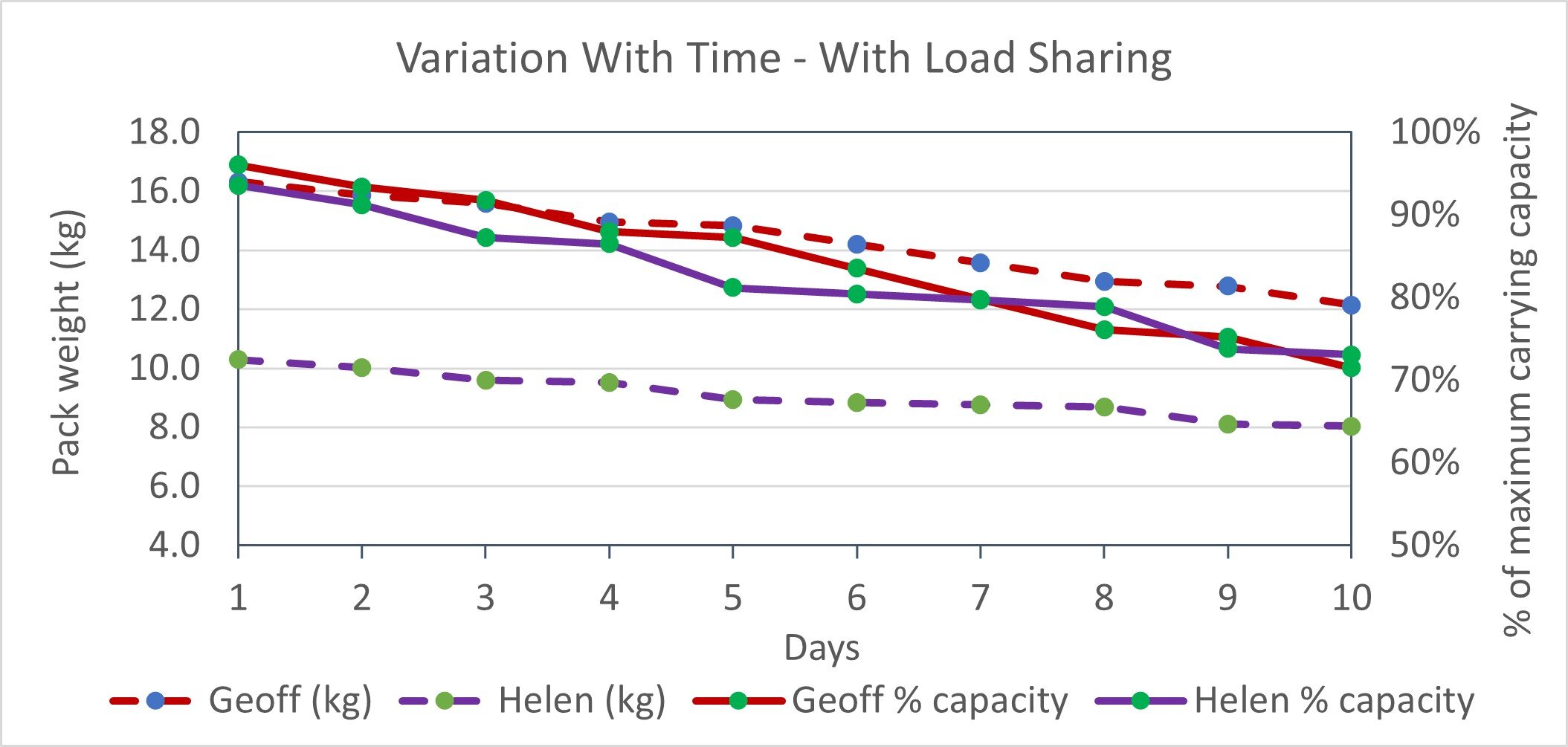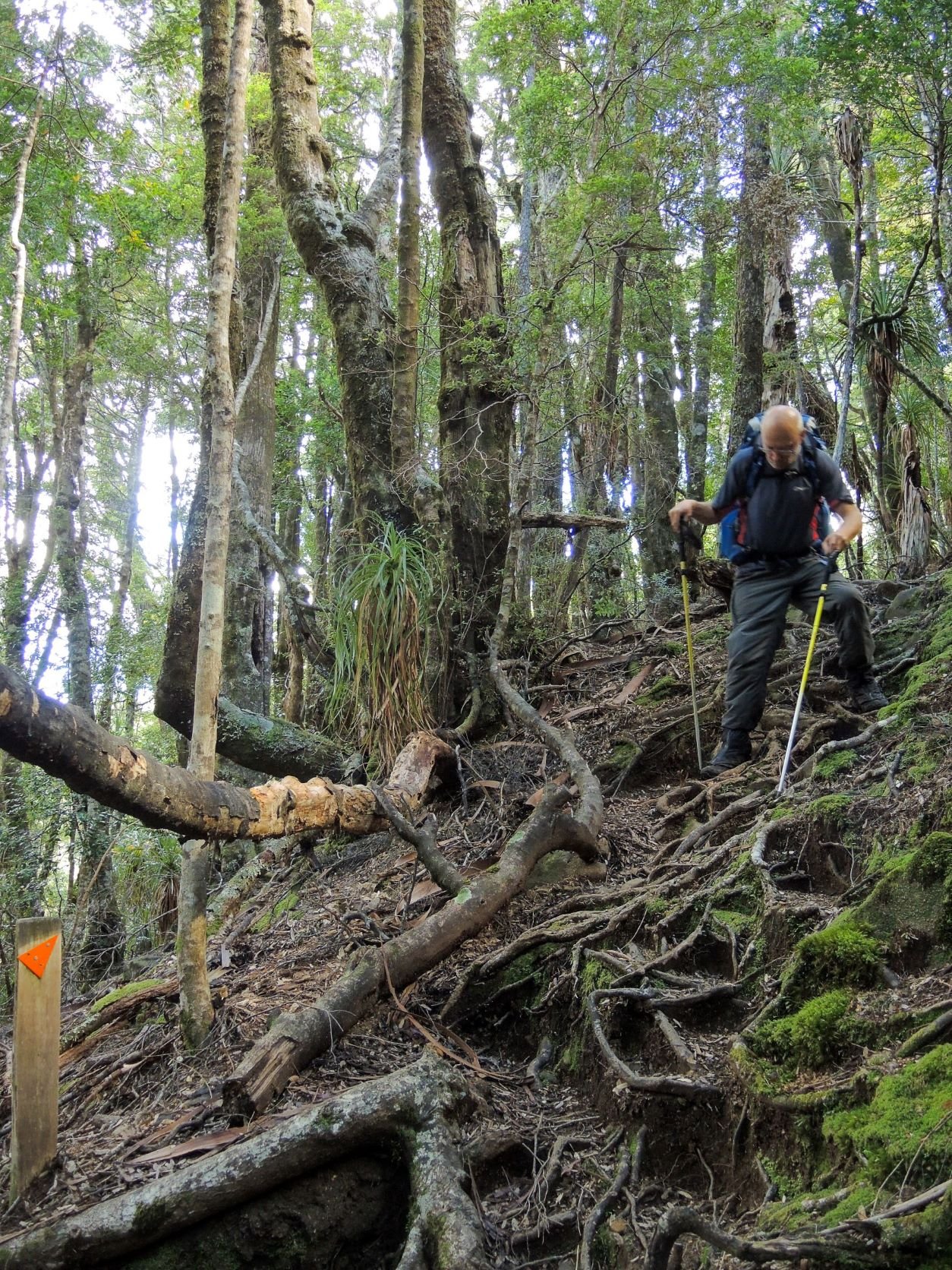Load Sharing for Two
Managing Pack Weight During the Hike
If you hike primarily with a partner, it’s likely that one of you is stronger or faster than the other, unless you are one of those lucky perfectly matched hiking duos! Most of us twosomes are not so identical, however. If you are sharing gear – food, tent and kitchen, rather than walking independently, how then to transport that gear most efficiently and effectively as a team?
We share the load equally in accordance with what our bodies are comfortable doing. It’s not about sharing the weight equally! If one person is overloaded the fun goes for both people. If you load one person up to full capacity or even more than they can comfortably carry because they need to pull their “fair share” of the weight – you’ll end up walking alone!
In fact, we think our method is very fair because it balances the effort we contribute. And it works for us – if it works for others, great! We hope our method will give you and your hiking partner some ideas to work out load sharing that might work for you too.
Identify Maximum Comfortable Multiday Combined Pack Weight
Our approach to managing pack weights is visualising that we are carrying one pack between us: we are a team. We split the weight between us at the start so we both have the weight we are comfortable carrying for several days, not what we can carry for several days. Neither of us enjoy death trudges crushed under leaden packs. Our maximum starting weights then are 17 kg and 11 kg, so we can carry between us 28 kg at the start. We can carry more but only for a day or two and for shorter distances.
These proportions will vary enormously for different partnerships. In some cases, the strongest person may be carrying 90% or even 100% of the load if their partner has health issues. If you are both equally strong, it might be 50-50. When you are hiking as a team, the important thing is not to divide automatically 50-50, or into my gear and your gear and hope distribution falls equitably, but into our gear, and then distribute to ensure equity.
I wonder why Helen’s back there? Hmmm ….. I must have got the load share wrong!
Divide Base Weight gear to Manage Pack Space
Our lightest combined base weight – that is, weight without consumables like water, food and fuel – is 16.4 kg (ultralight rain gear rather than bombproof goretex; we have since dropped another 2 kg for summer hiking). We each carry our own clothes, and Helen carries all her camera gear at the start as that is most convenient. Other items we divvy up with Helen taking bulky lighter items (tent, twin quilt) and I take heavier items. Our respective base weights end up as 7.9 kg (me) and 8.5 kg (Helen).
My lower base weight and extra space gives me capacity to carry most of the consumables. Helen’s base weight is inflated by her camera gear (2.5 kg).
A rare moment when I managed to grab the camera gear.
Consolidate Consumables into Logical Bundles.
We have at most 11.6 kg of consumables that we can carry: water, fuel and food. We split that between us to bring each pack weight up to each person’s comfortable multiday pack weight.
So for me that’s 9.1 kg of consumables, Helen has capacity for 2.5 kg of consumables. I normally carry the fuel, breakfasts, dinners, and usually lunches, all packaged for two people to save on weight and space. I carry the kitchen – again, far more weight efficient than two separate cook systems: we are operating as a team. Helen often carries the snacks. It’s clear to us who’s got what and where it is, and we aren’t unnecessarily diving into either pack. We bring each pack weight up towards the person’s capacity with water. We both carry some water for safety purposes.
Adjust Load Share During the Hike
We never used to do this, but now we progressively adjust load share through the hike. Our objective is to retain the same load sharing approach. So we do more than just reduce weight through consumption of consumables.
The following graph shows how our pack weights would reduce through straight consumption of consumables without redistribution.
Looks fair?
Well actually no.
Well, I’m always carrying more weight yes, and both our pack weights fall and are within our maximum carrying capacity yes. But … this next graph gives us a clue to how hard we are working each day. For that I’ve calculated and plotted our pack weight as a proportion of our maximum carrying capacity.
In fact, whilst we start out under the same relative load level of 96%, Helen is by the morning of the second day, already starting to work harder relative to myself – and the gap just gets bigger and by the mid-way point she is working around 10 % harder – each and every step of every day thereafter…
that can’t end well!
So, with this in mind, we shift the weight during the hike to try and make the relative loading on each of us similar – that seems fairer – and from experience produces hikers that can go the distance!
This is illustrated in the graph that follows.
The dotted lines are in kilograms, the solid lines the percentage of our individual maximum load carrying capacity. The two dotted lines track more in parallel than that with no redistribution, because we are shedding pack weight at similar rates.
The solid lines – the ones we are most interested in - track in a similar fashion with both starting and finishing at similar % of load capacity.
Helen says: “I didn’t really get what my engineer-brained Geoff was getting at and was for years reluctant to pass across gear as he was already carrying more than me. When I finally listened – properly! – on our Walls of Jerusalem hike, I at last understood. It’s often quite difficult for us women raised as feminists to differentiate between equality and equity when it involves physical differences between men and women. But ignoring the fact that my partner is stronger than me is fanciful and counterproductive. Men with female partners who are stronger than they are might find this equity approach even more difficult to accept. But it’s a sensible approach that promotes a more enjoyable experience for both of you if you hike as a team.”
The way we do this from a practical perspective is Helen simply passes an item she is carrying to me after the first day and then again as we progress through the hike.
That might be for example, the first aid kit, a camera lens, the remaining snacks – it doesn’t matter really as long as it is convenient and partly offsets the weight saving I’m making as we eat the food.
We also manage weights during each day – by further shedding if necessary - but more typically just using the water Helen is carrying first.
We are also mindful of the day ahead. If it is a harder day, with either a steep uphill (tougher on Helen) or steep downhill (tougher on me) or one of us is feeling tired or has knee or foot issues, then that effectively reduces your maximum carrying capacity, so we can adjust loads accordingly.
After operations on both knees, Geoff’s not too fond of steep slippery descents !
Slow but mostly steady!
Adjusting weight sharing through the hike is an easy and simple thing to do in order to balance the effort each of us has to put in. And it works - it allows us to do longer hikes and maximises our enjoyment – and for us that’s what it’s all about.









